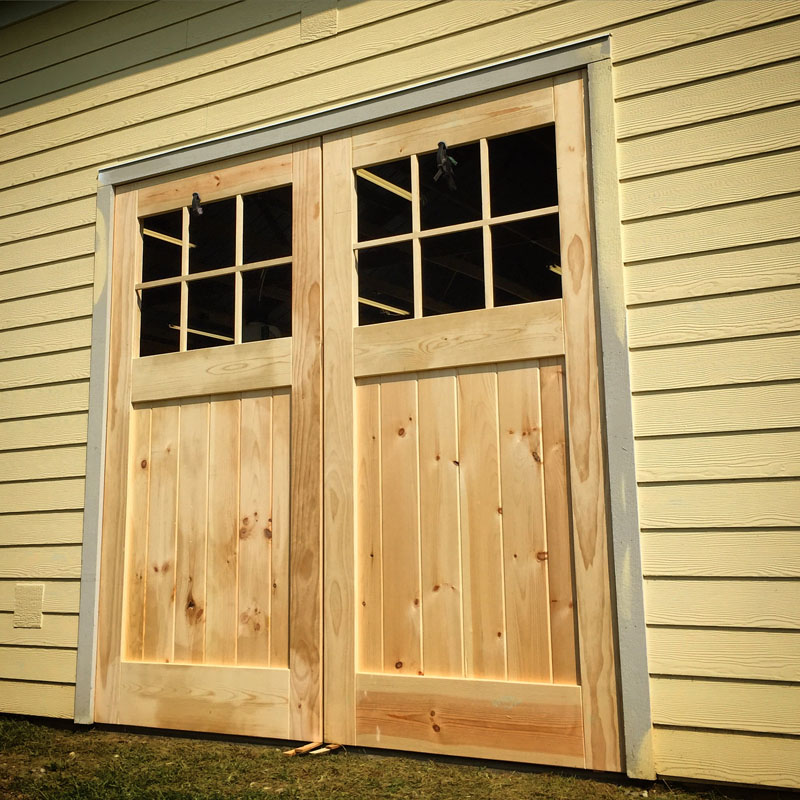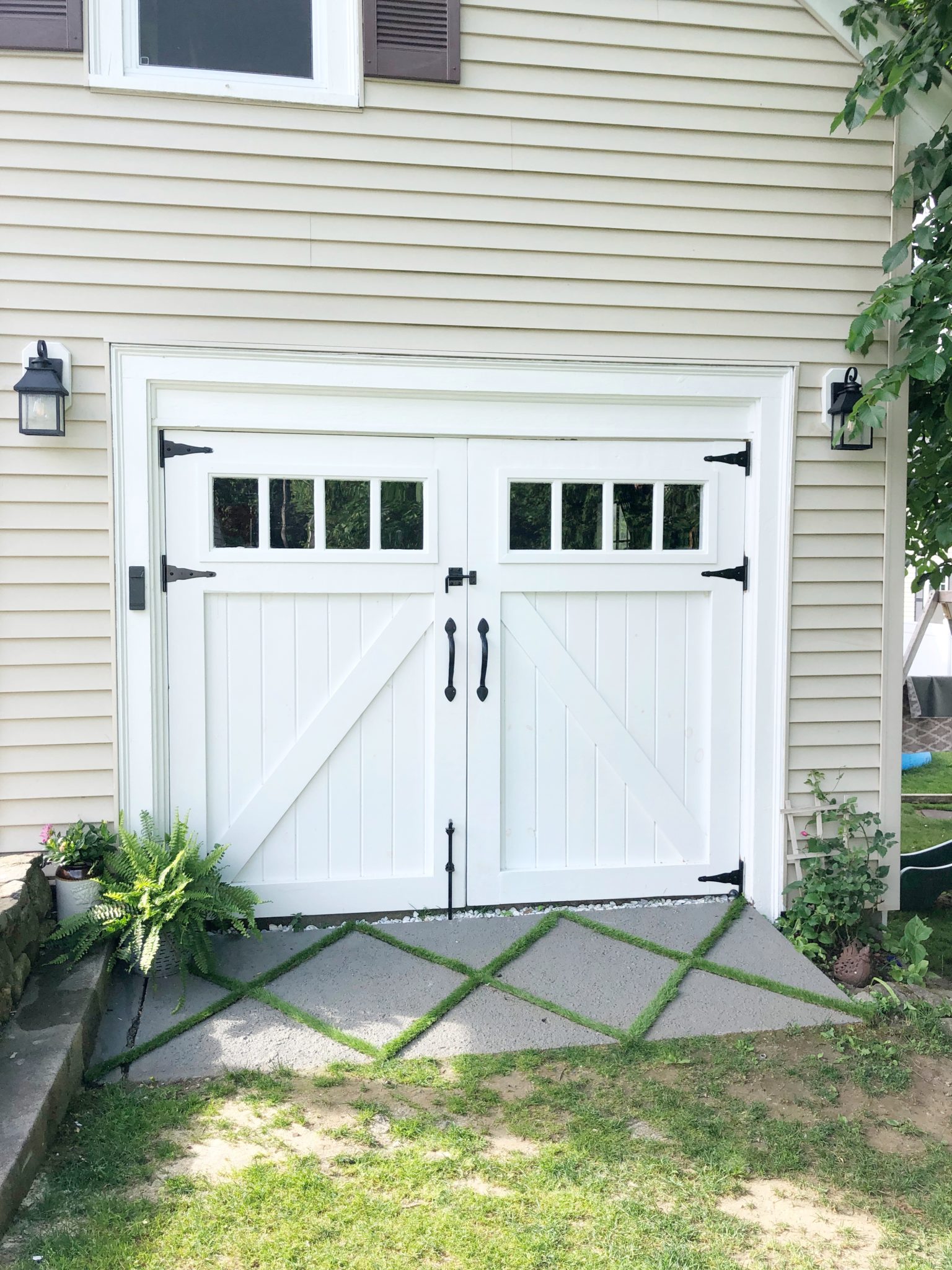To build swing out garage doors, start by designing the door frame and selecting appropriate hinges. Ensure the frame supports the door’s weight for smooth operation.
Building swing-out garage doors combines functionality with aesthetic appeal, offering a classic look that enhances your home’s exterior while providing easy access to your garage space. This type of door is ideal for those seeking to maximize their garage’s usability without compromising on style.
The construction process involves precise planning and attention to detail, ensuring the doors not only look great but also operate seamlessly. By choosing the right materials and following a step-by-step approach, homeowners can create a durable and efficient entryway that reflects their personal taste and meets their specific needs. Engaging in this project not only improves your property’s curb appeal but also adds value by incorporating a traditional element with modern functionality.
Introduction To Swing Out Garage Doors
Swing out garage doors blend classic charm with modern functionality. These doors, reminiscent of old carriage houses, open outward. They offer a distinctive look to any home. They also provide a practical solution for garages with limited headroom.
Benefits Of Choosing Swing Out Doors
- Space-efficient: Ideal for garages with limited ceiling space.
- Easy access: Simplifies entry and exit without overhead obstructions.
- Customizable: Offers various designs to match any home style.
- Durable: Withstands frequent use with minimal wear and tear.
Tools And Materials Needed For Installation
| Tool/Material | Use |
|---|---|
| Measuring Tape | For accurate door measurements |
| Level | To ensure doors hang straight |
| Screwdriver Set | For hardware installation |
| Drill | To secure door components |
| Hinges | For door movement |
| Lumber | Door frame construction |
| Exterior-grade Plywood | For door panels |
| Weather-stripping | To seal against elements |
Design Considerations For Swing Out Doors
Swing out garage doors combine old-world charm with modern functionality. They swing open like traditional barn doors, making a unique statement. Before building, planning is key. Think about the look and how it matches your home. Consider space around your garage. Doors should swing freely without hitting obstacles.
Selecting The Right Wood Type
Wood choice affects durability, maintenance, and style. Common options include:
- Redwood: Resists decay, looks great.
- Cedar: Natural bug repellent, weathers nicely.
- Plywood: Budget-friendly, needs more upkeep.
- Hardwood: Lasts long, offers elegance.
Choose based on climate, budget, and desired look. Treat wood for longer life.
Sizing Your Garage Door
Size matters for the perfect fit. Measure the opening width and height. Add extra for framing. This ensures a snug fit and smooth operation.
| Door Size | Width | Height |
|---|---|---|
| Single | 8 to 10 feet | 7 to 8 feet |
| Double | 16 feet | 7 to 8 feet |
Check local building codes. Some areas have standard sizes. Custom sizes are possible. They may cost more.
Preparing For Installation
Building swing-out garage doors adds charm and functionality to your home.
Proper preparation ensures a smooth installation process.
Follow these steps to get your space ready for new swing-out doors.
Measuring Your Garage Door Space
Accurate measurements are crucial for custom garage doors.
Start by measuring the width and height of your current garage door opening.
Note any obstructions that could hinder door movement.
Record these numbers; they will guide your door size selection.
Creating A Workspace And Safety Measures
Clear the area around your garage door.
This creates a safe workspace.
Ensure all tools and materials are within reach.
Wear safety goggles and gloves.
Keep a first-aid kit nearby.
These steps help prevent accidents.
- Clear the garage door area
- Arrange tools and materials
- Wear protective gear
- Have a first-aid kit ready

Credit: www.cmoist.com
Building The Door Frame
Today, we dive into Building the Door Frame for swing-out garage doors. This part is key to a sturdy, lasting door. Let’s break down the steps, ensuring you can follow along easily.
Cutting And Assembling The Frame
First, gather your materials. You need wood, screws, and tools. Measure your garage door opening. Cut the wood to fit these measurements. Remember, accuracy is vital for a perfect fit. Use a saw for cutting. Be careful and precise. Next, lay out the cut pieces on the ground. This shows how they fit together. Now, assemble the frame. Use screws to join the pieces. Tight spots need a drill. Make sure the frame is square. A right angle tool helps here.
Attaching Cross Bracing For Stability
Cross bracing adds strength. It stops the frame from wobbling. Here’s how:
- Measure diagonally across the frame.
- Cut two pieces of wood to these measurements.
- Place them in an X shape inside the frame.
- Screw them in place. Use two screws per end.
This X makes the door much stronger. It can now resist wind and use better. Your swing-out garage doors will last longer and work better.
Panels And Insulation
Building swing out garage doors is exciting. The panels and insulation are key parts. They keep your garage warm and looking good. Let’s dive into how to add panels and choose the right insulation.
Adding Panels To The Frame
First, measure your door frame. You need these numbers to buy panels. Panels come in many materials. Wood and metal are popular. Think about your home’s look when choosing.
- Wood panels give a classic look.
- Metal panels are strong and last long.
Cut the panels to fit your frame. Use a saw carefully. Next, attach the panels to the frame. Screws or nails work well for this. Make sure they are tight and secure.
Choosing And Installing Insulation
Insulation keeps your garage warm in winter and cool in summer. There are many types:
- Foam Board: Good for tight spaces.
- Fiberglass: Cheap and easy to install.
- Spray Foam: Great for filling gaps.
Measure your door to know how much insulation you need. Cut the insulation to fit inside your panels. Some insulation sticks on its own. Others need glue or tape to stay in place. Make sure there are no gaps. Gaps let cold air in.
Remember, the right panels and insulation make a big difference. They keep your garage looking sharp and feeling comfy. Take your time choosing and installing. Your hard work pays off when you see your new garage doors swing open.
Finishing And Weatherproofing
Once you’ve built your swing out garage doors, the next step is crucial. It’s time to finish and weatherproof them. Proper finishing and weatherproofing are vital. They protect your doors against harsh weather. They also ensure your doors last for years.
Sealing And Painting The Wood
Choose the right sealant and paint for your garage doors. It shields the wood from moisture and decay. Here are the steps:
- Clean the wood surface thoroughly.
- Apply a quality primer. Let it dry.
- Paint with exterior-grade paint. Use two coats.
Ensure even coverage. Pay attention to edges and corners. These areas are prone to wear and tear.
Installing Weather Stripping
Weather stripping keeps out wind, rain, and pests. Follow these steps:
- Measure the door edges. Cut stripping to size.
- Peel and stick or nail in place, depending on the type.
- Check for gaps. Adjust as needed for a snug fit.
Test the doors after installing. Ensure they open and close smoothly. The stripping should not interfere with the door’s movement.
Hardware And Hinges Installation
Installing the right hardware is key for building swing-out garage doors. Strong hinges ensure smooth operation and longevity. Let’s dive into the process of selecting and installing the correct hardware for your swing-out garage doors.
Selecting The Right Hinges
Choosing the right hinges is crucial. The size and weight of your doors dictate the hinge type. Look for heavy-duty hinges designed for garage doors. They must support the door’s full weight. Consider weather-resistant materials to prevent rust and corrosion.
- Check the door weight: Match it with the hinge capacity.
- Material: Opt for galvanized or stainless steel.
- Size: Hinges should be proportional to door size.
Attaching Hinges And Door Handles
Attaching the hinges and handles correctly ensures your doors swing smoothly. Follow these steps:
- Mark the hinge positions: Use a pencil for precision.
- Drill pilot holes: This makes screwing easier and prevents wood splitting.
- Secure the hinges: Use screws provided with the hinges.
- Attach the handles: Position them for easy reach.
Ensure all screws are tight. Test the door movement. Your swing-out garage doors should now open and close effortlessly.
Mounting The Doors
Mounting the doors is a critical step in building swing-out garage doors.
Aligning The Doors For Proper Swing
Correct alignment ensures smooth operation. Follow these steps:
- Place each door in the opening.
- Check the door’s level and plumb.
- Use shims to adjust the door’s position.
- Mark hinge spots on the door and frame.
Ensuring alignment requires precision. Use a spirit level for accuracy.
Final Adjustments And Testing
Once doors are hung, perform these checks:
- Open and close each door slowly.
- Observe any sticking or swinging issues.
- Adjust hinges for better movement.
Test the doors multiple times. Look for consistent, smooth swings.
Maintenance Tips For Swing Out Garage Doors
Keeping swing out garage doors in top shape is crucial. Regular maintenance ensures smooth operation and extends door life. Simple steps can prevent common issues. Follow these tips for door care.
Regular Cleaning And Inspection
Clean doors regularly to maintain appearance and function. Use mild soap and water. Check for rust, especially on hinges and hardware. Inspect seals for weatherproofing. Look for cracks or wear. Tighten loose screws and bolts. Ensure smooth movement without strange noises.
- Wipe down doors with a soft cloth.
- Check for surface damage or corrosion.
- Examine seals for tightness and integrity.
- Adjust and lubricate hinges yearly.
Troubleshooting Common Issues
Address problems quickly to avoid bigger repairs. Listen for grinding or squeaking. This indicates lubrication is needed. If doors stick or won’t close properly, check for alignment issues. Ensure tracks are clear of debris.
| Issue | Tip |
|---|---|
| Door Sticking | Check alignment and clear tracks. |
| Noisy Operation | Lubricate hinges and rollers. |
| Surface Damage | Fill cracks, sand, and repaint. |
Remember: Regular care prevents costly fixes. Tackle small issues immediately. Keep your swing out garage doors working like new with these simple maintenance tips.

Credit: jordecor.com
Credit: realcraft.com
Frequently Asked Questions
What Materials Are Needed For Swing-out Garage Doors?
Swing-out garage doors typically require sturdy materials such as wood, steel, or fiberglass, along with hinges, handles, and a secure locking mechanism.
Can Diy Enthusiasts Install Swing-out Garage Doors?
Yes, skilled DIY enthusiasts can install swing-out garage doors with the proper tools, hardware, and a clear set of instructions.
How Much Space Is Needed For Swing-out Doors?
Swing-out garage doors need sufficient clearance space in front of the garage to allow the doors to open fully without obstructions.
What Are The Benefits Of Swing-out Garage Doors?
Swing-out garage doors offer a classic aesthetic, full driveway clearance when open, and can be more durable due to fewer moving parts.
Are Swing-out Garage Doors Customizable?
Swing-out garage doors are highly customizable in terms of size, material, design, window placement, and hardware to match your home’s style.
Conclusion
Crafting your own swing-out garage doors is a rewarding project that enhances your home’s curb appeal and functionality. By following the steps outlined in this guide, you’ll be equipped with the knowledge to tackle this DIY task with confidence. Remember, precision and patience are key to creating a durable and stylish entrance to your garage.
Start building today and transform your garage into a showcase of your handiwork and ingenuity.




